Strings, Solos, Legends: The Best Guitarists Ever Ranked
March 31, 2025
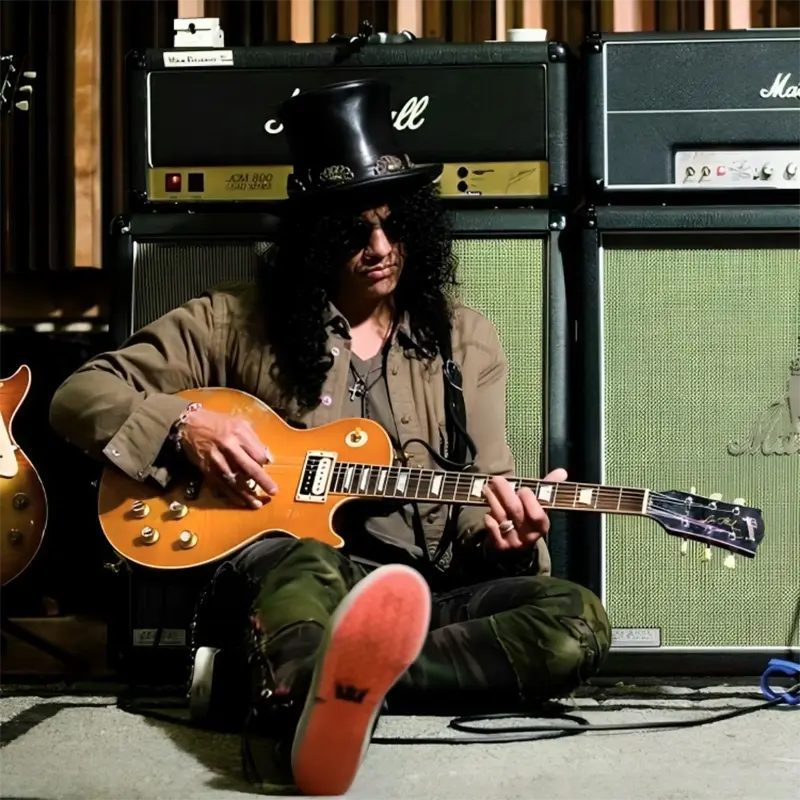
There’s something magical about the sound of a guitar. Whether it’s the raw energy of a distorted riff, the soul of a slow blues solo, or the emotion in a few well-placed notes, the guitar has been the voice of rebellion, love, pain, and joy for decades. It’s more than just an instrument. It’s a storyteller, and behind every great guitar is a musician with a story worth telling.
Some guitarists go beyond just being technically skilled. They shape genres, change the way people play, and build emotional bridges between their music and the hearts of millions. These artists don’t just play notes—they speak a language that transcends time and culture. From the psychedelic swirls of Hendrix to the bluesy grit of Stevie Ray Vaughan, each guitarist in this list brought something unique to the world of music.
This article isn’t about ranking who’s fastest or most complicated. It’s about the players who left a real impact. The ones who gave people goosebumps, made them pick up guitars, or inspired them to feel something deeper through sound. These are the legends some still with us, some long gone but all of them unforgettable.
So let’s take a journey through the lives of 10 of the greatest guitarists the world has ever known. Get comfortable, maybe put on your favorite album, and enjoy the stories behind the people who helped shape music history one string at a time.
Jimi Hendrix (1942–1970)
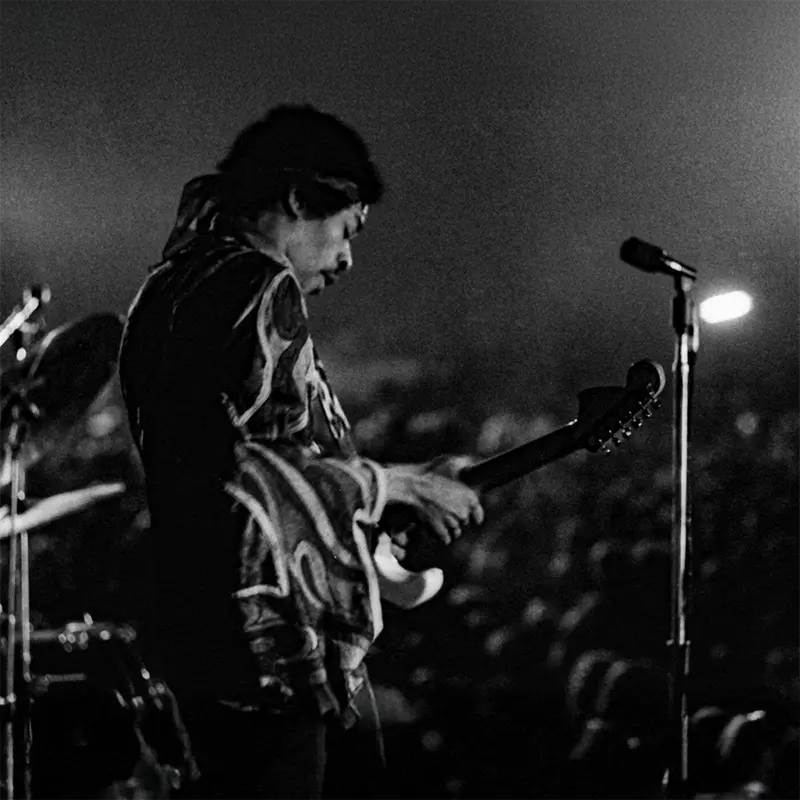
Born on November 27, 1942, in Seattle, Washington, Jimi Hendrix had a challenging childhood, often living with relatives or acquaintances due to his parents' unstable relationship. Despite these hardships, he developed a deep passion for music, drawing inspiration from artists like B.B. King, Muddy Waters, and Robert Johnson. At 15, Hendrix acquired his first guitar and, being self-taught, dedicated countless hours to mastering the instrument.
In 1961, Hendrix enlisted in the U.S. Army and was assigned to the 101st Airborne Division. However, his military career was short-lived; he was honorably discharged in 1962 after an injury. Following his discharge, Hendrix began working as a session musician, performing with notable acts such as the Isley Brothers and Little Richard. These experiences honed his skills and exposed him to the vibrant rhythm and blues scene.
Seeking greater creative freedom, Hendrix moved to New York City's Greenwich Village in 1966. It was there that he was discovered by Chas Chandler, bassist of the Animals, who offered to manage him and brought him to London. In the UK, Hendrix formed the Jimi Hendrix Experience with bassist Noel Redding and drummer Mitch Mitchell. The band's fusion of rock and psychedelic sounds quickly captivated audiences.
The Jimi Hendrix Experience released their debut album, Are You Experienced, in 1967, featuring iconic tracks like "Purple Haze" and "Hey Joe." Hendrix's innovative use of feedback, distortion, and wah-wah pedals revolutionized electric guitar playing. His electrifying performance at the Monterey Pop Festival, where he famously set his guitar on fire, further solidified his status as a groundbreaking artist.
Despite his meteoric rise, Hendrix faced challenges, including managerial disputes and the pressures of fame. He continued to push musical boundaries with albums like Axis: Bold as Love and Electric Ladyland. Tragically, Hendrix's life was cut short on September 18, 1970, in London. His death at the age of 27 marked the loss of a prodigious talent whose influence on rock music remains unparalleled.
Eric Clapton (1945–Present)
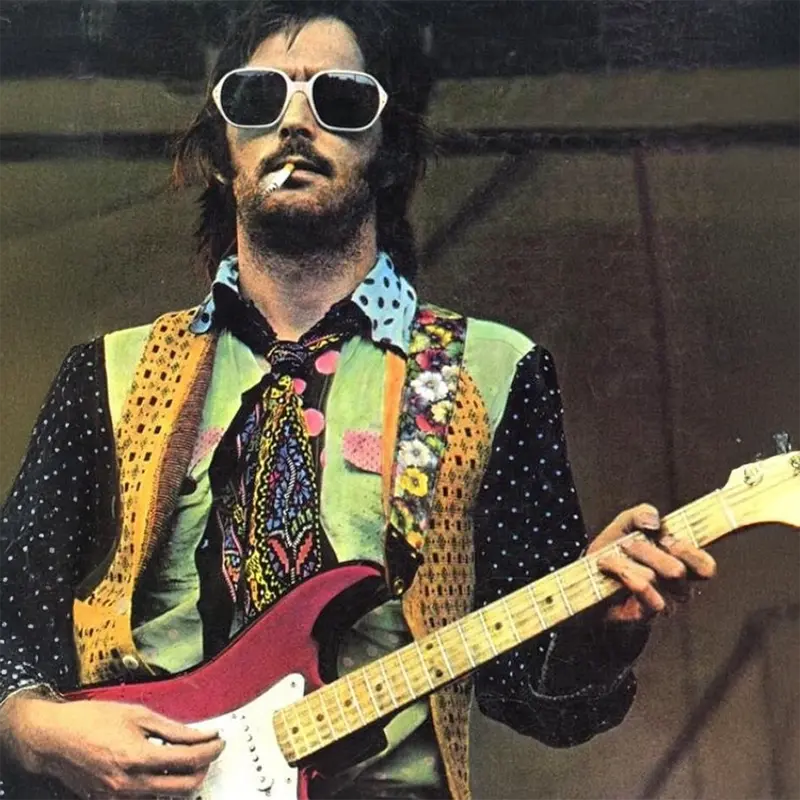
Eric Patrick Clapton was born on March 30, 1945, in Ripley, Surrey, England. Raised by his grandparents, he grew up believing they were his parents and that his mother was his sister. This revelation profoundly impacted him, contributing to the depth and emotion evident in his music. Clapton developed an early interest in the blues, drawing inspiration from artists like B.B. King and Muddy Waters.
Clapton's professional career began in the early 1960s with the Yardbirds, a band that blended rock and blues influences. His exceptional guitar skills earned him the nickname "Slowhand." In 1965, seeking a purer blues sound, he left the Yardbirds to join John Mayall & the Bluesbreakers. The album Blues Breakers with Eric Clapton showcased his mastery and solidified his reputation as a premier blues guitarist.
In 1966, Clapton co-founded Cream with bassist Jack Bruce and drummer Ginger Baker. The power trio became known for their virtuosic playing and improvisational live performances, producing classics like "Sunshine of Your Love" and "White Room." Despite their success, internal tensions led to the band's dissolution in 1968.
Clapton's subsequent projects included Blind Faith and Derek and the Dominos, with whom he recorded "Layla," a song inspired by his unrequited love for Pattie Boyd. The track remains one of his most celebrated works. Throughout the 1970s and 1980s, Clapton pursued a solo career, releasing hits like "Wonderful Tonight" and a cover of Bob Marley's "I Shot the Sheriff," which introduced reggae to a broader audience.
Tragedy struck in 1991 when Clapton's four-year-old son, Conor, died in an accident. This profound loss led him to write "Tears in Heaven," a poignant ballad that resonated worldwide and earned him multiple Grammy Awards. Clapton's ability to channel personal grief into his music has endeared him to fans, showcasing his vulnerability and depth as an artist.
Over the decades, Clapton has collaborated with numerous artists and continued to release music, exploring various genres while staying true to his blues roots. His dedication to the craft and his influence on both contemporaries and successors have cemented his legacy as one of the greatest guitarists in history.
Jimmy Page (1944–Present)
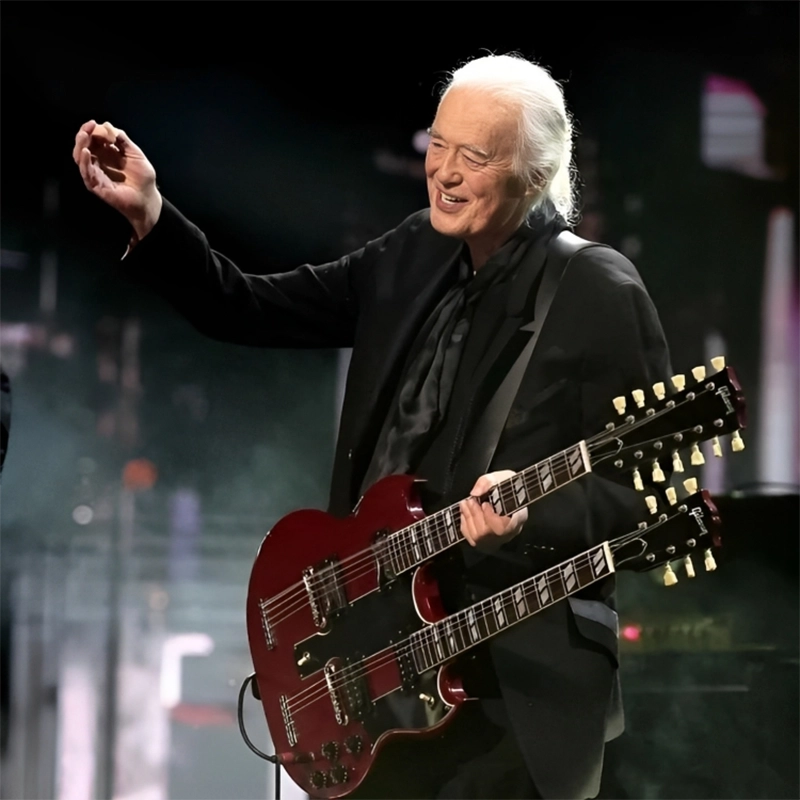
James Patrick Page was born on January 9, 1944, in Heston, Middlesex, England. His father was an industrial personnel manager, and his mother worked as a doctor's secretary. The family moved to Epsom, Surrey, when Page was eight years old. At the age of 12, he received his first guitar, a Spanish-style acoustic, and although he took some lessons in nearby Kingston, he was largely self-taught. Early influences included rockabilly guitarists like Scotty Moore and James Burton, who had played with Elvis Presley. Page's dedication to the instrument was evident as he often brought his guitar to school, sometimes resulting in it being confiscated.
Page's professional career began as a session musician in London during the early 1960s. His versatility and skill made him one of the most sought-after session guitarists in England. He contributed to recordings by artists such as The Who, The Kinks, and Donovan. This period honed his adaptability and deepened his understanding of various musical styles.
In 1966, Page joined the Yardbirds, initially as a bassist before transitioning to lead guitar alongside Jeff Beck. After Beck's departure, Page became the sole guitarist, steering the band's sound towards heavier, more experimental territories. When the Yardbirds disbanded in 1968, Page formed a new group to fulfill remaining tour commitments. This ensemble, initially dubbed the New Yardbirds, would soon be known as Led Zeppelin.
Led Zeppelin, comprising Page, Robert Plant, John Paul Jones, and John Bonham, released their eponymous debut album in 1969. The band's fusion of blues, rock, and folk elements, combined with their powerful live performances, quickly garnered them a massive following. Page's innovative guitar work was central to the band's sound, with iconic riffs in songs like "Whole Lotta Love" and "Black Dog." His use of alternate tunings, slide guitar, and the violin bow on tracks like "Dazed and Confused" showcased his experimental approach.
Beyond his guitar prowess, Page served as the band's producer, meticulously crafting their albums' sonic landscapes. Albums like "Led Zeppelin IV," featuring the legendary "Stairway to Heaven," and "Physical Graffiti" are testaments to his production skills. The band's mystique was further enhanced by Page's interest in the occult and symbolism, often reflected in their album art and stage presence.
After Led Zeppelin disbanded in 1980 following Bonham's death, Page engaged in various projects, including film soundtracks and collaborations with artists like Paul Rodgers in The Firm. He also reunited with Plant and Jones for select performances, including the 2007 Ahmet Ertegun Tribute Concert. Page's influence on rock guitar is profound, with his techniques and style inspiring countless musicians. His legacy is cemented by his induction into the Rock and Roll Hall of Fame twice: once with the Yardbirds and again with Led Zeppelin.
David Gilmour (1946–Present)
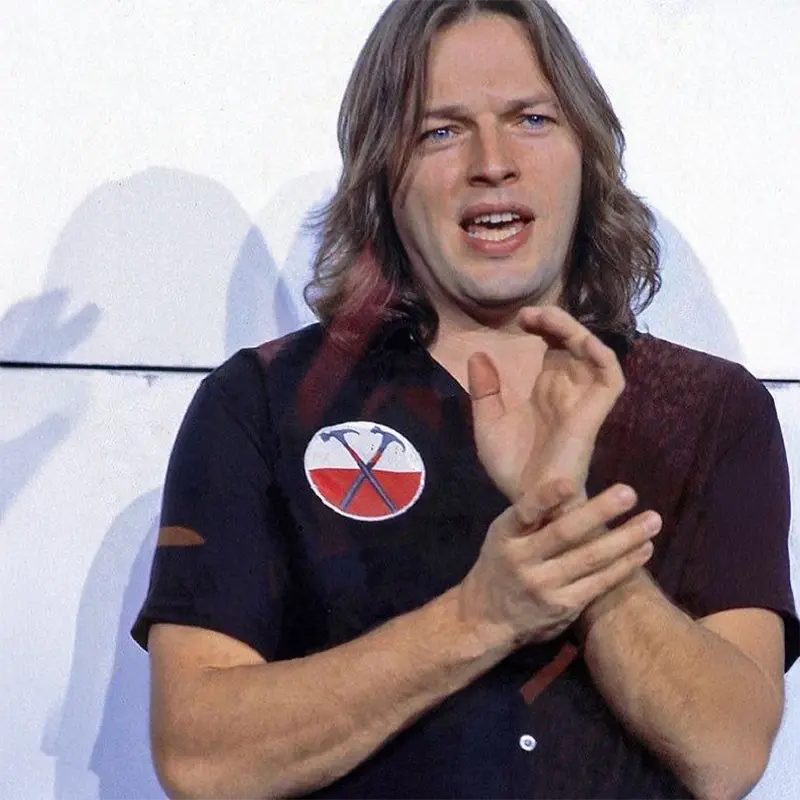
David Jon Gilmour was born on March 6, 1946, in Cambridge, England. He grew up in a well-educated family—his father was a senior lecturer in zoology at Cambridge University, and his mother was a teacher and film editor. Gilmour’s interest in music began at an early age; he was captivated by rock and roll and blues music from the U.S., especially artists like Lead Belly and Hank Marvin. As a teenager, he taught himself to play the guitar, often spending hours trying to replicate what he heard on records.
Before joining Pink Floyd, Gilmour played in several local bands in Cambridge and London, including Jokers Wild. He also busked around Europe, even living in France for a time and performing for food and shelter. In 1967, he was invited to join Pink Floyd as the fifth member to support frontman Syd Barrett, whose mental health was deteriorating rapidly. When Barrett became unable to perform, Gilmour stepped into the role of lead guitarist and vocalist.
Gilmour brought a new musical identity to Pink Floyd. His playing was expressive, slow, and atmospheric—far from the shredding styles common in rock. He preferred feel over speed, often making one sustained note sound like a sentence of emotion. His solos on songs like “Comfortably Numb,” “Time,” and “Shine On You Crazy Diamond” are widely regarded as some of the most moving in rock history. Gilmour’s clean tone, masterful bends, and melodic phrasing became defining features of the band's evolving sound.
As the band released classic albums like The Dark Side of the Moon, Wish You Were Here, and The Wall, Gilmour’s influence grew. While bassist Roger Waters drove much of the band's concept and lyrical content, Gilmour's contributions to arrangement, production, and especially guitar work were essential. When Waters left the band in the 1980s, Gilmour assumed leadership and released A Momentary Lapse of Reason and The Division Bell under the Pink Floyd name, both commercial successes.
Outside of Pink Floyd, Gilmour has enjoyed a strong solo career. His 2006 solo album On an Island reached number one on the UK charts, and his 2015 follow-up Rattle That Lock continued his legacy of deeply personal, atmospheric rock music. He has collaborated with a range of artists including Kate Bush, Paul McCartney, and David Bowie, always bringing his signature tone and emotional depth to any project.
Gilmour is also known for his philanthropy—he’s donated millions to charities, including proceeds from property sales and concerts. Reserved and thoughtful, he avoids the spotlight but is revered by both fans and fellow musicians. David Gilmour remains a symbol of tasteful, emotionally-driven guitar playing. His work has influenced generations of musicians who prioritize soul, space, and melody over complexity or speed.
B.B. King (1925–2015)
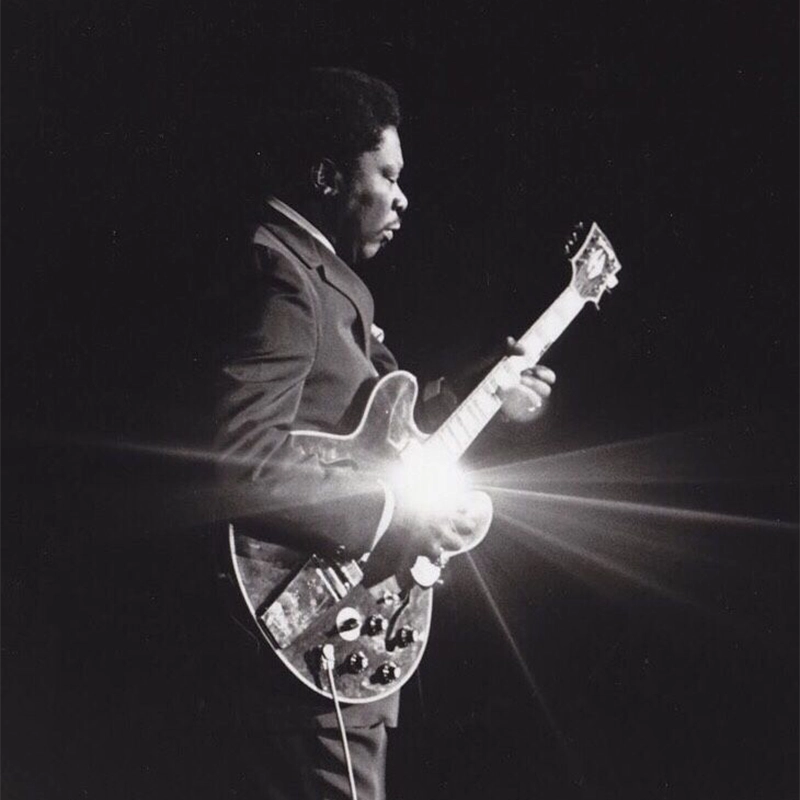
Riley B. King, widely known as B.B. King, was born on September 16, 1925, near Itta Bena, Mississippi. Raised by sharecropper parents, his early years were marked by poverty and hardship. His mother left his father when King was very young, and after his mother's death when he was nine, he was raised by his maternal grandmother. Despite these challenges, King found solace in music, particularly through the gospel sounds at his local church. His pastor introduced him to the guitar, igniting a passion that would define his life.
In his teens, King honed his guitar skills and performed on street corners and at local gatherings. Seeking greater opportunities, he moved to Memphis, Tennessee, in 1946, a city renowned for its vibrant blues scene. There, he connected with his cousin Bukka White, a celebrated blues musician, who became his mentor. King's big break came when he performed on Sonny Boy Williamson's radio program on KWEM, leading to steady engagements at the Sixteenth Avenue Grill in West Memphis and a ten-minute spot on WDIA, a pioneering African American radio station.
King's exposure on WDIA earned him the nickname "Beale Street Blues Boy," later shortened to "B.B." His growing popularity led to a recording contract with Bullet Records in 1949, followed by RPM Records. His early recordings, including "3 O'Clock Blues," "You Know I Love You," and "Woke Up This Morning," showcased his distinctive style—a blend of fluid string bending, shimmering vibrato, and staccato picking. These elements, combined with his emotive vocals, set him apart in the blues genre.
Throughout the 1950s and 1960s, King toured extensively, earning a reputation for his electrifying live performances. He named his beloved Gibson guitar "Lucille," a tradition that began after he rescued his instrument from a fire during a performance in Arkansas. The story goes that two men were fighting over a woman named Lucille, causing the fire; King named his guitar after her as a reminder to avoid such situations.
King's crossover into mainstream success was marked by his 1969 rendition of "The Thrill Is Gone," which earned him a Grammy Award and introduced his music to a broader audience. Collaborations with artists like Eric Clapton, U2, and others further cemented his status as a bridge between blues and other musical genres. Over his career, King received numerous accolades, including induction into the Blues Foundation Hall of Fame in 1984 and the Rock and Roll Hall of Fame in 1987. He was also honored with the NARAS Lifetime Achievement Grammy Award and multiple honorary doctorates from institutions such as Yale and Berklee College of Music.
B.B. King continued to perform well into his later years, sharing his passion for the blues with audiences worldwide. He passed away on May 14, 2015, in Las Vegas, Nevada, leaving behind a legacy that profoundly influenced countless musicians and solidified his title as the "King of the Blues."
Chuck Berry (1926–2017)
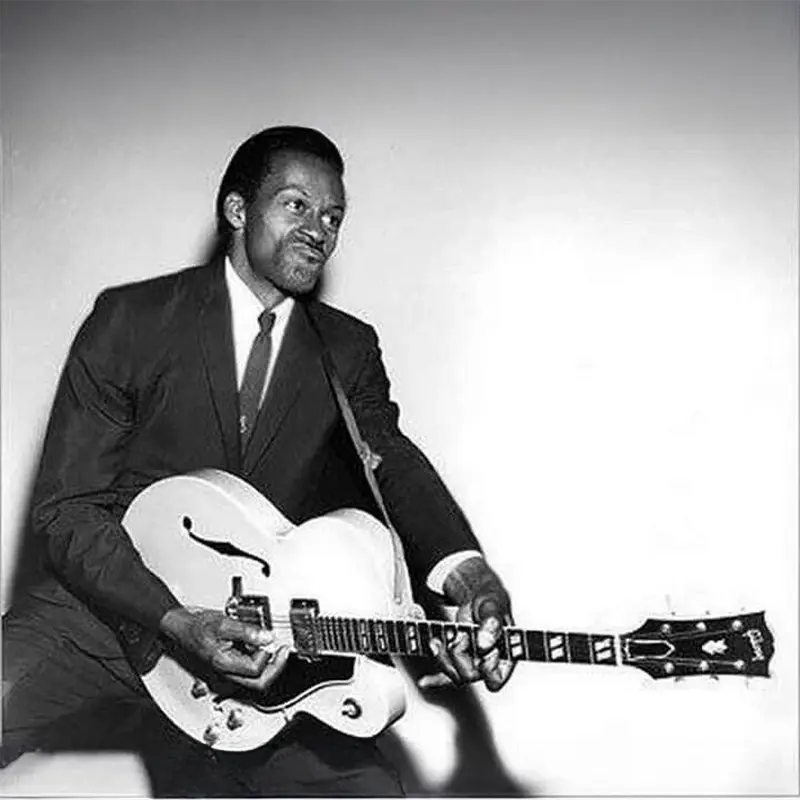
Charles Edward Anderson Berry, born October 18, 1926, in St. Louis, Missouri, is often called the father of rock and roll. Raised in a middle-class African-American family, he had access to both education and early exposure to music. He began performing at school talent shows and developed an interest in blues and swing music. Despite some early legal troubles—he served three years in a reformatory as a teenager—Berry returned determined to pursue music seriously.
In the early 1950s, he joined pianist Johnnie Johnson’s trio, which played a mix of blues and swing in local clubs. Berry’s big break came in 1955, when he traveled to Chicago and met Muddy Waters, who introduced him to Chess Records. Berry’s first single, “Maybellene,” was a revolutionary track—it blended rhythm and blues with country, creating a sound that was fresh and appealing to a wide audience. The song became a hit, selling over a million copies and charting at number one on the Billboard R&B chart.
Chuck Berry’s genius lay not only in his guitar playing but also in his songwriting. Songs like “Roll Over Beethoven,” “Rock and Roll Music,” and especially “Johnny B. Goode” captured the excitement, rebellion, and optimism of 1950s youth culture. His lyrics often reflected themes of cars, high school, and freedom—topics that resonated with teenagers across racial and social boundaries. His signature stage move, the "duck walk," became iconic, symbolizing the energy and charisma of early rock and roll.
Berry’s guitar style combined rhythm and lead parts in a way that gave his music a constant sense of motion and drive. His double-stop riffs and distinctive intros became foundational elements for generations of rock guitarists. Artists like The Beatles, The Rolling Stones, and Bob Dylan all cited him as a key influence. Keith Richards once said, “If you want to learn rock guitar, start with Chuck Berry. Everything’s there.”
His career was not without controversy. In the early 1960s, Berry served prison time under the Mann Act, and later, he faced criticism for his sometimes erratic live performances. Nevertheless, his contributions to music were undeniable. He continued touring into his 80s, often performing with local pickup bands in different cities. In 1986, he was one of the very first artists inducted into the Rock and Roll Hall of Fame, and his influence on modern music is immeasurable.
Chuck Berry passed away on March 18, 2017, at the age of 90. His legacy is embedded in the DNA of rock music. From guitar riffs to lyrical themes, Berry laid the groundwork for the genre, and his songs are still played, covered, and celebrated worldwide. His name remains synonymous with the roots of rock and roll—a true pioneer whose impact will never fade.
Eddie Van Halen (1955–2020)

Born Edward Lodewijk Van Halen on January 26, 1955, in Amsterdam, Netherlands, Eddie moved with his family to Pasadena, California, in 1962. His father, Jan Van Halen, was a professional musician, and both Eddie and his brother, Alex, were immersed in music from a young age. Initially trained in classical piano, Eddie's musical journey took a pivotal turn when he picked up the guitar, while Alex gravitated towards the drums.
In the early 1970s, the Van Halen brothers formed a band called Mammoth, which eventually evolved into Van Halen with the addition of vocalist David Lee Roth and bassist Michael Anthony. The band's self-titled debut album, released in 1978, showcased Eddie's groundbreaking guitar techniques, particularly the use of two-handed tapping, as exemplified in the instrumental track "Eruption." This approach not only captivated audiences but also set a new standard for guitarists worldwide.
Van Halen's energetic performances and Eddie's virtuosic playing propelled the band to stardom. Albums like Van Halen II (1979), Women and Children First (1980), and Fair Warning (1981) solidified their place in rock history. The 1984 album, featuring the hit single "Jump," marked a stylistic shift with the incorporation of synthesizers, showcasing Eddie's versatility as a musician.
Beyond his work with the band, Eddie was an innovator. He held patents for guitar-related inventions, including a support device that allowed musicians to play hands-free, reflecting his commitment to advancing the instrument's capabilities.
Eddie's personal life was marked by both triumphs and challenges. He married actress Valerie Bertinelli in 1981, and their son, Wolfgang, later joined Van Halen as the bassist. Despite his musical success, Eddie faced health issues, including a prolonged battle with cancer, which led to his passing on October 6, 2020.
Eddie Van Halen's legacy endures through his revolutionary guitar techniques, innovative spirit, and the timeless music he created with his band. His influence continues to inspire generations of musicians and fans alike.
Slash (1965–Present)
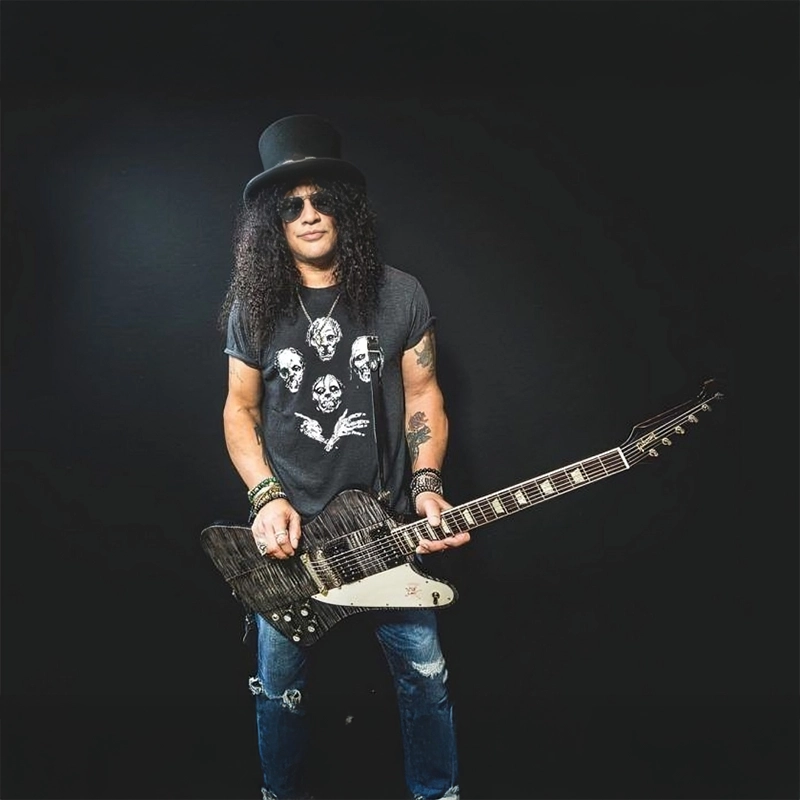
Saul Hudson, known to the world as Slash, was born on July 23, 1965, in Hampstead, London, England. His mother, Ola Hudson, was a well-known costume designer who worked with artists like David Bowie, and his father, Anthony Hudson, designed album covers for musicians such as Neil Young and Joni Mitchell. Music and art were embedded in his upbringing, and although his parents separated when he was young, they remained supportive of his creative interests. At age five, Slash moved with his mother to Los Angeles, a place that would eventually shape his musical destiny.
As a teenager in L.A., Slash was exposed to a vibrant rock scene and became obsessed with the guitar after hearing Aerosmith’s Rocks. He began practicing relentlessly—sometimes up to 12 hours a day—developing a style that fused classic blues phrasing with raw, hard rock aggression. His early influences included Jimmy Page, Eric Clapton, Jeff Beck, and Joe Perry. Despite being largely self-taught, Slash’s technical ability and feel for melody quickly set him apart from other aspiring guitarists.
In 1985, he joined a newly forming band called Guns N’ Roses, alongside Axl Rose, Duff McKagan, Izzy Stradlin, and Steven Adler. Their debut album, Appetite for Destruction (1987), exploded onto the music scene and became the best-selling debut album of all time. With hits like “Sweet Child O’ Mine,” “Welcome to the Jungle,” and “Paradise City,” Slash’s gritty tone, emotive bends, and memorable solos defined a new era of hard rock. His use of a Gibson Les Paul guitar through a Marshall amp became iconic.
During the late '80s and early '90s, Guns N' Roses released a string of successful albums, including G N' R Lies and the ambitious Use Your Illusion I & II. Slash’s guitar work ranged from ferocious riffs to beautifully composed solos, showcasing his range and versatility. However, rising tensions within the band, fueled by creative differences and personal struggles, led to Slash’s departure from Guns N’ Roses in 1996.
After leaving the band, Slash formed several projects to continue his musical journey, including Slash's Snakepit and later the supergroup Velvet Revolver, with Scott Weiland on vocals. Velvet Revolver’s debut album Contraband (2004) was a commercial success and introduced Slash’s sound to a new generation. In 2010, he launched his solo career, collaborating with artists like Myles Kennedy, Ozzy Osbourne, and Fergie on his self-titled solo album. His ongoing project, Slash featuring Myles Kennedy and the Conspirators, has released several albums and continues to tour globally.
In 2016, Slash reunited with Axl Rose and Duff McKagan for the Not in This Lifetime... world tour, which became one of the highest-grossing tours in music history. Beyond music, he’s also ventured into film production and become an outspoken advocate for wildlife conservation and addiction recovery—openly discussing his path to sobriety after years of substance abuse. Slash remains one of the most recognizable and respected guitarists in rock history, celebrated not just for his technical skill, but for his ability to inject emotion and personality into every single note.
Stevie Ray Vaughan (1954–1990)
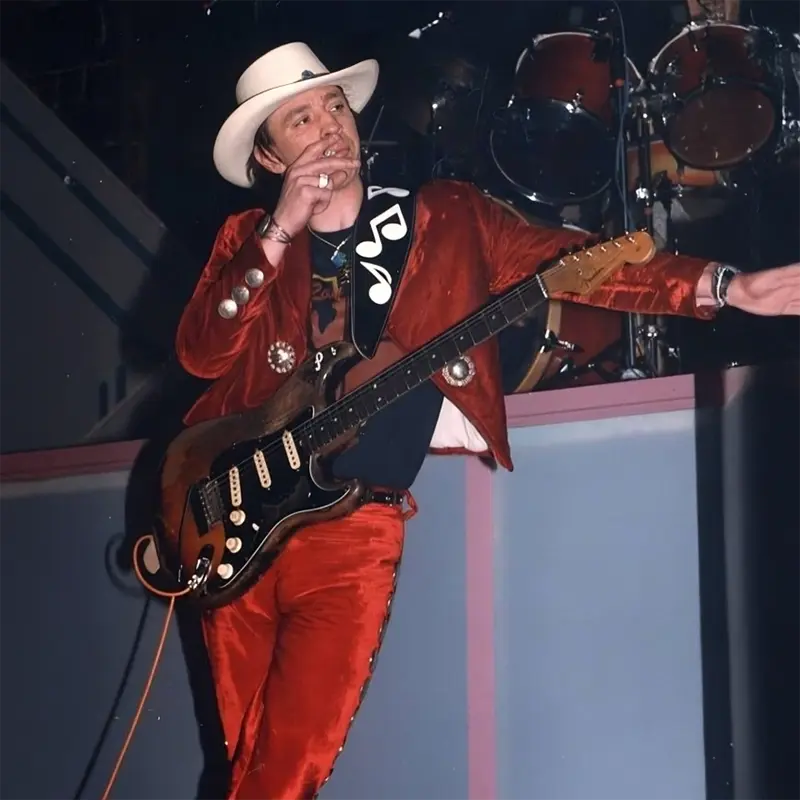
Stevie Ray Vaughan was born on October 3, 1954, in Dallas, Texas. Raised in a working-class family, he was inspired by his older brother Jimmie Vaughan, who also became a celebrated blues guitarist. Stevie started playing guitar at age seven, using a toy guitar before moving on to more serious instruments. He fell in love with the sounds of blues legends like Albert King, Freddie King, and Muddy Waters, spending hours in his bedroom trying to mimic their licks by ear.
Vaughan dropped out of high school at 17 to pursue music full-time, playing in a series of local bands in Texas. Eventually, he formed Double Trouble, a power trio that would become his primary musical vehicle. By the early 1980s, his explosive performances began to attract national attention. His breakthrough came when David Bowie asked him to play lead guitar on the Let’s Dance album in 1983. That same year, Stevie Ray Vaughan & Double Trouble released Texas Flood, a raw and blues-heavy debut that reignited interest in electric blues.
His style was unmistakable—aggressive yet soulful, gritty but precise. Vaughan played a worn-out Fender Stratocaster, strung with thick gauge strings and tuned a half-step down, which gave his tone a deep, punchy quality. He combined the fire of Hendrix with the soul of Albert King, often losing himself completely in solos that felt more like emotional outbursts than rehearsed parts. Songs like “Pride and Joy,” “Cold Shot,” and “Lenny” showed both his technical mastery and vulnerability.
Despite his growing success, Vaughan struggled with substance abuse, particularly alcohol and cocaine. By the mid-1980s, his health and career were at risk, but he made the brave decision to get sober in 1986. His recovery not only saved his life but brought a new clarity to his music. In 1989, he released In Step, an album that reflected his personal growth and remains one of his most acclaimed works. He sounded more focused than ever, and his playing reached a new level of emotional depth.
Tragically, just as he was entering what many believe would have been the peak of his career, Vaughan died in a helicopter crash on August 27, 1990, after a performance in Wisconsin. He was only 35 years old. The loss was devastating to the music world, but his legacy has endured. Stevie Ray Vaughan is remembered not only as one of the greatest blues guitarists of all time but also as a deeply expressive artist who poured his entire soul into every note he played.
Angus Young (1955–Present)

Angus McKinnon Young was born on March 31, 1955, in Glasgow, Scotland, the youngest of eight siblings. In 1963, his family emigrated to Sydney, Australia, where his older brothers George and Malcolm became key figures in the local music scene. Angus initially played the banjo before switching to guitar, influenced by blues and early rock and roll. While he wasn’t formally trained, he developed a sharp, instinctive playing style that was both fast and full of attitude.
In 1973, Angus and Malcolm formed AC/DC, a high-voltage rock band built around hard riffs, driving rhythms, and rebellious spirit. The band quickly gained attention in Australia and then internationally with albums like High Voltage, Let There Be Rock, and Highway to Hell. Angus stood out not only for his electrifying guitar work but also for his signature stage presence: duck-walking across the stage in a schoolboy uniform, sweat flying, legs twitching like he was plugged into the amp.
When original vocalist Bon Scott died in 1980, the band could have ended, but Angus and the rest of AC/DC decided to push forward. They brought in Brian Johnson as the new frontman and released Back in Black, a tribute to Scott and one of the best-selling albums of all time. Angus's raw, bluesy guitar tone and unforgettable riffs in songs like “You Shook Me All Night Long,” “Hells Bells,” and the title track helped define what hard rock would sound like for the next four decades.
Unlike many guitarists who rely on complex solos or technical tricks, Angus keeps things simple but powerful. He’s all about feel, energy, and unforgettable hooks. His playing is rooted in Chuck Berry-style rock and blues, but turned up to eleven. Every note he plays seems designed to make your head bang or your foot stomp, and that’s exactly how he wants it.
Offstage, Angus is known to be quiet and reserved—completely different from his wild onstage persona. He’s remained committed to AC/DC for over 50 years, rarely straying into side projects or public controversy. That consistency has earned him the respect of fans and musicians around the world. Angus Young isn’t just a guitar player—he’s a living embodiment of rock and roll, a symbol of pure, unfiltered energy that still tears up stages into his late 60s.
The Strings That Shaped the World
Looking back at these ten legendary guitarists, it’s clear that greatness doesn’t come from speed or flash—it comes from connection. Each of these musicians found their own voice through six strings, and in doing so, gave a voice to millions. Their styles were different, their journeys unique, but they all had one thing in common: they made people feel something real.
Whether it was Hendrix setting his guitar on fire, Gilmour making a single note sing like a full sentence, or Angus Young sprinting across the stage in a school uniform—these are moments that shaped music history. They didn’t just play songs. They created eras, influenced generations, and reminded us that music is one of the most powerful forms of expression we have.
And while times change, good music doesn't fade. New guitarists will always emerge, but the echoes of these legends will continue to ring out—every time someone plugs in an amp, bends a note, or plays their heart out in a garage somewhere. These guitarists didn’t just change music. They changed people.

